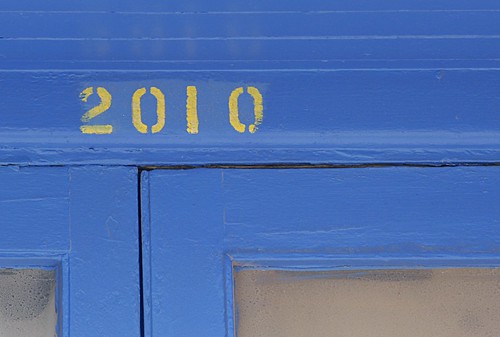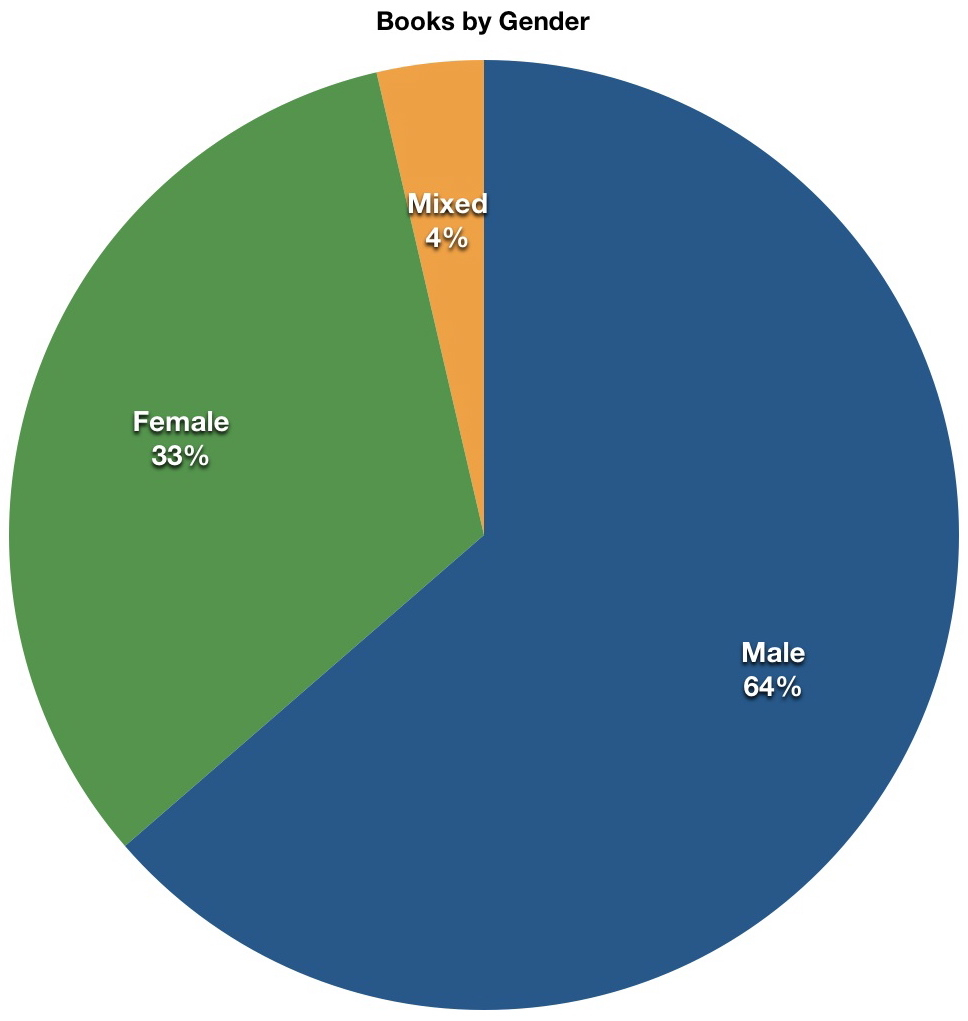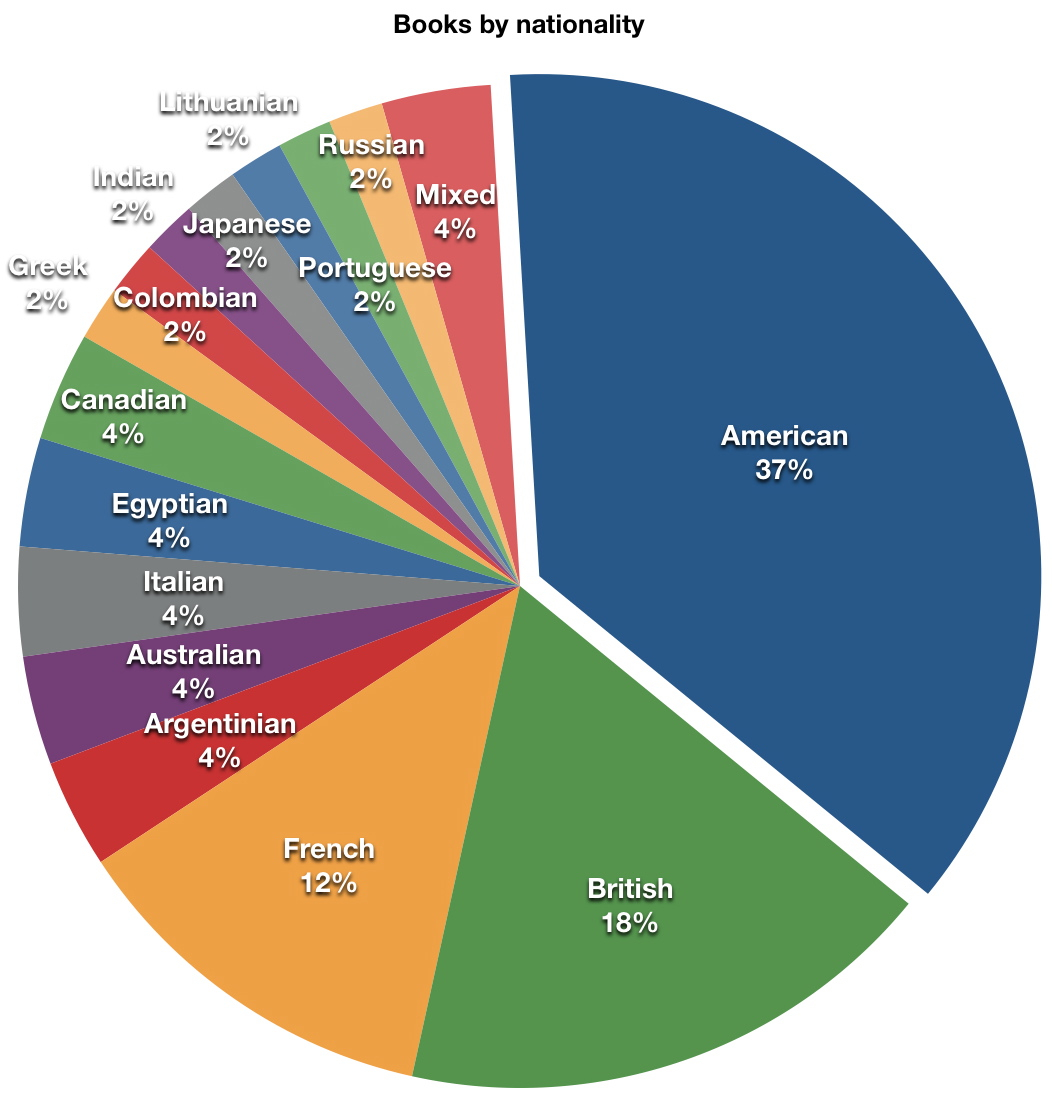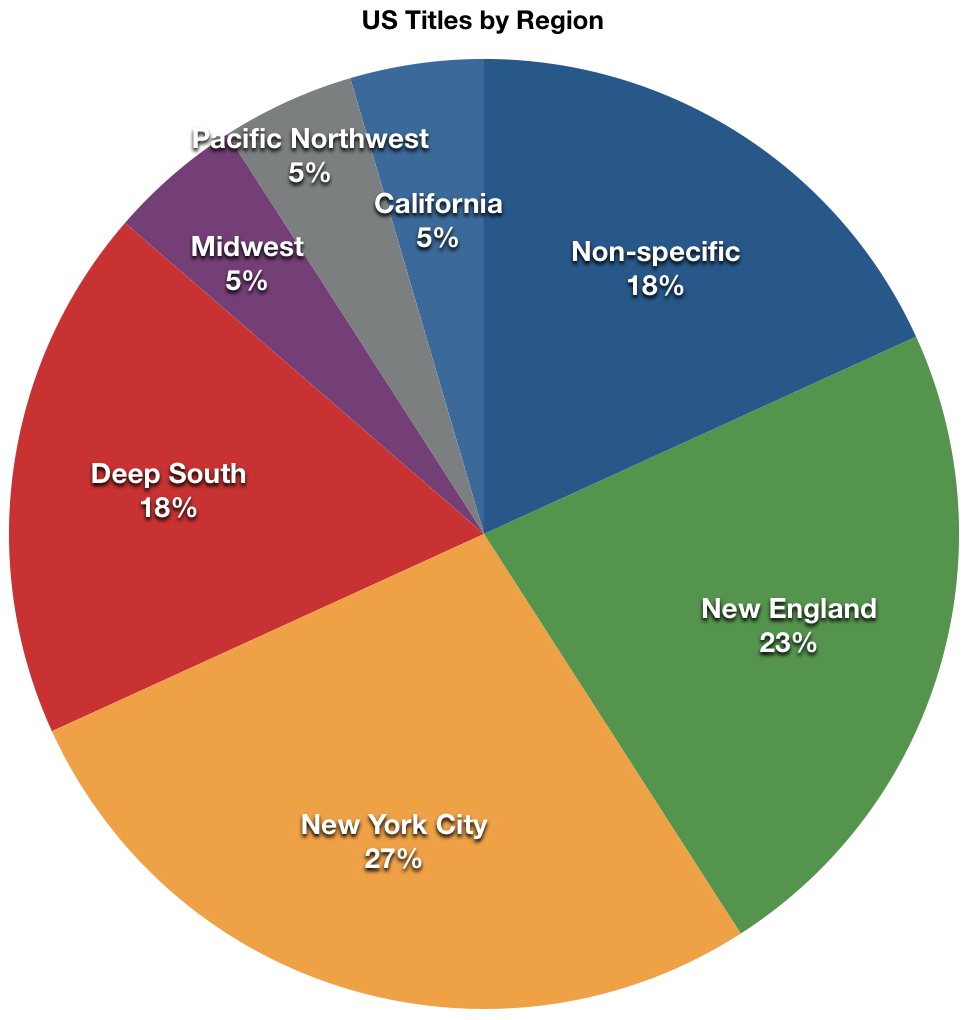Well, 2010 has been an excellent reading year for me. It started out with a revisitation of one of my favorite authors with Woolf in Winter; reading the posts and comments of so many other people on some of my favorite novels was an amazing experience, and made me feel like the college semester I spent writing about Woolf had an actual, real-life application.
In February I had an intense but contradictory experience reading Julio Cortázar's Hopscotch, which provoked me to write three separate posts (one adulatory, one angry, and one interested), each as long as my regular, already-lengthy entries. I'm still not sure how I feel about Hopscotch overall, but any book that gets me that engaged must have something going for it.
In March, my perusal of Volume IV of the Paris Review Interviews got me interested in several authors I hadn't read before, including John Ashbery, whose Notes from the Air later became a surprise hit with me.
April was a red-letter month. It brought a shared read of Georges Perec's Life a User's Manual, which delighted pretty much all the Wolves involved; the discovery of Lydia Davis's micro-stories in Almost No Memory; and a French-language read of Émile Zola's Germinal, which convinced me that I actually do enjoy naturalism if it's done right. I also got to rip a new one for my old friend Henry David Thoreau; at the time I was worried that I'd offend people with this post, but in actuality it apparently made me some new friends. Who knew?
With May came the conclusion of my Essay Mondays project, in which writing about a different essay every week gave me a nice grounding in the genre and introduced me to some new favorites, including Joan Didion. In June I went on honeymoon to Hawaii, lay on the beach with such fluffy love stories as Alexandr Solzhenitsyn's Cancer Ward, and bought a copy of Cormac McCarthy's All the Pretty Horses containing a note which reads "Reminds me of Garrison Keillor"—still a favorite book-related joke for the year. This summer, too, I finally got around to sampling Shirley Jackson's short stories, and became a firm convert to her gothic, darkly humorous style.
In September I discovered one of my top reads of the year, Simone de Beauvoir's Mémoires d'une jeune fille rangée, whose combination of existential feminism and keen philosophical insight into the author's early development had me practically swooning. October brought Frances's three-part Madame Bovary readalong, which left me impressed with Flaubert's keen powers of prosody and observation, but irked at his smug world-view. Flaubert did teach both Richard and me the vocab word redingote, which will come in very useful the next time we want to buy frock coats in Paris.
Meanwhile, the clear highlights of my reading in November and December were both Anne Carson projects: Nox, a beautifully-packaged, thoughtful and heart-wrenching elegy for the author's dead brother, and An Oresteia, her breathtaking translations of Aiskhylos, Sophokles and Euripides. I'd say An Oresteia ties with Simone de Beauvoir (and Woolf, of course) as my Best Book of 2010.
Speaking of Beauvoir, I read five books in French this year, which is four more than last year, and included the somewhat difficult Flaubert. I feel very good about this! I can feel my French getting better all the time as I garner a better sense of the language's flow and build my vocab. I'll be reviewing Irène Némirovsky's gorgeous Suite Française shortly, and in 2011 I hope to read at least one novel in French every month. We'll see how I do with that goal.
And now, onto the flashy stuff! (Click any pie-chart to enlarge. Also, if total percentages don't add to 100, blame rounding.)
Firstly, a breakdown by author's gender: obviously, there's about a two-thirds to one-third predominance by male authors in my 2010 reading, and one of my goals for 2011 is a more gender-balanced reading list. (FYI, the "Mixed" category in all these charts refers to anthologies with contributions from different genders/nationalities/regions.) I think it's telling that, although I read twice the number of books by men this year as books by women, my year-end highlights above feature an almost exact gender split, which I take as a sign that it's time to seek out more books like the Carson, Beauvoir, Woolf, Didion, Némirovsky and Jackson that so impressed me in 2010.
A breakdown of 2010 reads by author's nation of origin (or main country of residence, in some cases) shows a clear domination by American, British, and French titles (67% collectively), but with a decent spread throughout the remaining 33%. Every continent except Antarctica is represented, although in some cases only by one or two countries/books. In 2011 I'll definitely be expanding the French section as I prepare for, and then recover from, David and my trip to France in May and June, and I also hope to pick up some books on that trip by francophone authors from Africa and the Caribbean, regions where my reading was almost nonexistent this year. Marianna Ba and Véronique Tadjo are at the top of that list, but I would also welcome suggestions! (Keep in mind that I'm not a huge fan of magical realism.)
Because the US (my own country of origin) is so gigantic and diverse, I thought it might be interesting to split that big blue wedge further, into regions. I often think the various regions of the US are more different from one another than many contiguous countries.
There is something surprising about this breakdown. Regular readers, have you spotted it? That's right: NEW YORK CITY. In case you're new here, I don't care about New York City. I have have never found myself susceptible to the interest or romance of it the way I have with London or Paris—or hell, even San Francisco. When I visited, the highlight of my trip was spending quality time with my mom, and going to the amazing medieval art museum at The Cloisters—whose defining characteristic? Is that it's outside the city. People, one of my best friends moved to Manhattan over a year ago and I have not visited her. Yet somehow, 27% of the American lit I've read this year has been New York-centric. This must change. My resolution for American lit read in 2011 is to focus on Southern Regionalist and Western authors, and take a break from the New Yorkers for a while. (Ironically, The Wolves' first 2011 selection is set in New York, but that's okay! I'll just stick to that one book and not read (m)any others.)
So, to recap, goals for 2011:
- At least one book in French every month;
- More female authors;
- More francophone authors from African and/or Caribbean countries;
- Fewer authors from/books set in New York City, to be replaced with those from the Deep South and the West.
I think I can handle that!






What fun! Your charts are very cool. I hadn't thought of dividing up my U.S. reading by region, and now I'm curious how that would play out. I'm guessing NYC would feature prominently in my list too. What did you do about books set in a number of different places? (We're talking about where the book takes place not where the author is from?)
Oh my god, pie charts. I want to make pie charts! These are awesome.
Very clever! And colorful! It makes me want to get out a redingote and run up to Barnes & Noble and look for those books! (Or, more correctly, ride up to Barnes & Noble...)
Love the charts and it sound like you have great plans for 2011!
Dorothy: Thanks! The regional break-up was surprisingly difficult/complicated, actually...I sort of just used my judgment. If a book came close to concerning all regions equally (like Howard Zinn's Peoples' History for example), it went in the "Non-Specific" category, but a book like Patricia Highsmith's The Price of Salt still counted as NYC even though they take the cross-country trip during the second half, because most of it takes place there. It's divorced from author place of residence; for example the Memphis Minnie book I read counted as the Deep South even though the authors live in Chicago.
Lu: Haha, thanks! I'd love to see them if you put pie charts together!
Jill: Well I have two words for you about that: TAKE PICTURES. :-D
Gavin: Thanks, I'm looking forward to it!
You know I love you but I am sitting here laughing hysterically at the charts. Knowing that there is something wrong with me that I have no inclination to examine my reading life in such a way. My unexamined reading life is clearly not worth living. :)
What I can say is that your year has been most impressive, and that I have truly loved being part of the ride from time to time. And if you have a plan for Southern lit, I would be delighted to join in next year. One of my Hall of Shame geographic areas.
That's a remarkable year's reading. The de Beauvoir is high on my list for early 2011. If you haven't read her collected letters to Sartre, I recommend them highly.
The charts are brilliant, inspiring. One of my goals is for more gender balance to my reading next year.
It has been a blast to meet you through our book blogs this year. I've learned from your insight, and am thrilled to meet a reader with what seems a similar literary perspective.
I love your pie charts! You read some great stuff this year. I hope next year is even better.
Your year in reading is amazing - what an adventure! I love the charts, and your goals for next year are fun. I'm with Frances on being curious about your plans regarding Southern lit. Do you have anything specific in mind?
Wow Emily, I think you have just taken end of year reading stats to a whole new level with your pie charts! With all the reading in French you've been doing your trip to France will be especially awesome. Looking forward to seeing where your reading takes you in 2011!
Frances: Haha, I think we both know any kind of reading life is worth living, examined or not! As for the charts, I must admit they speak to my obsession with spreadsheets...possibly something to worry about rather than celebrate. :-) I'll give some thought to the Southern lit idea; I have a few titles already on my TBR and more in my virtual wish list...
Anthony: What a sweet comment. Thank you so much, and I feel the same about having discovered your blog via Woolf and Flaubert - very much looking forward to your thoughts on Beauvoir and the other Modernists you'll be reading in 2011!
Melissa: Thanks for the pie chart love, lady!
Sarah: Well, apparently there is some demand for a Southern reading project. Intriguing! I admit I didn't have anything too structured in mind, but now I will give it some thought. It's one of my favorite lit regions, so it would certainly be fun to have some discussions around it this year!
Stefanie: Haha, thanks! I'm hoping you're right on the France preparation front; at the very least, I got to read some amazing books.
I love your pie charts! If I'm feeling adventurous next year I might try to do some, and also to keep track of the nationality of the authors I read. Also, I clearly need to read some Simone de Beauvoir!
"More female authors" was my resolution last year too, and I'm not sure how much better I did. But when I listed my favorites I found female authors decently represented (5/12). In proportion to my reading overall, people of color did surprisingly well too, coming in at 4/12. But I know I could do better.
Those pie charts are so cool! Actually, I think the majority of the books I've read were non-American. In terms of language, Spanish and French were most popular. I wonder what my pie charts would look like?
Nymeth: Yes, you do! You would love her. I hear the new translation of The Second Sex is far better than the first in terms of incorporating her existentialism into the feminist arguments. I'm looking forward to the Year of Feminist Classics read of it very much. :-)
EL Fay: Yes, why is it so easy to list into a heavily male-dominated reading list? I tried to make a chart based on race/ethnicity, but it gave me a huge headache. Like, is Bolaño considered a "person of color" because he was Chilean? He looks pretty pasty white to me. Ditto for Cortázar. And then, for the nonfiction authors I didn't know their race in many cases...in the end it just ended up feeling too arbitrary. I think I did better with that than in years past, but as you say could definitely do better in future.
So many great (shared) memories here, Emily, although the pie charts go against my luddite blogger tendencies...Perec, Thoreau as a "sophomoric douchebag," etc. Too funny. Also love all your plans for next year (well, except for the NYC one, on which I'm neutral), so all best for 2011! Your person of color discussion with E.L. Fay is quite interesting: in addition to the questions you raise, it's quite difficult to assign a true nationality to many Lat Am authors, for example, since many write/wrote in exile (voluntary or otherwise). I always think of Bolaño as Chilean, but he wrote most of his work in Spain. And for Argentinean authors like Cortázar, the POC definition is truly slippery: most Argentines have Euro ancestry (primarily Italian and Spanish), so classifying them as POC isn't quite as accurate for many of them as say classifying Bolivians as POC might be. Anyway, thanks for another year of fine blogging and thought-provoking and Thoreau-provoking posts!
Western authors?
Consider my ears pricked. :) I've been on something of a western/NW kick this year. If you haven't read House of Sky by Ivan Doig, I encourage you to look it up.
I also love Mr. Anthony Doerr (Idaho author of recent acclaim). His books aren't tremendously challenging, but they're atmospheric and a quick, pleasant read.
I've also been interested in reading A Country Called Home by Kim Barnes.
Hah - DFW is from California, right? Infinite Jest starts on Saturday! ;)
I love your intra-US breakdown! Theoretically at least I'm really into regional literature, and I've been following a bit of blog discussion here and there this year about whether it's sort of dying out due to the rise of program fiction, creative writing programs, general rootlessness, etc. But I agree with you that regional variations in the US are huge.
Do you think any of your NYC focus is because of some of these same factors, especially the program fiction issue? I'm not sure what exactly falls in there for you, but sometimes it seems like half of all new fiction takes place in NYC, and I'm so over it. Way back when, I sort of wanted to live there; now you couldn't pay me to (I'm there frequently enough though). And I'm getting pretty sick of reading about it too.
Richard: You don't fool me with your luddite comment - I saw that embedded YouTube video on your blog! :-) Seriously, 2010 = great reading memories. And you make some excellent points about the whole POC-allocation debate. I am just as happy that I didn't spend the time making another chart about that.
Ariel: Yay, it's always so fun when you comment here! Sadly I must be the only person on earth not interested in DFW...so sad! Will follow your reading with interest, however. And thanks for the PNW picks; my only Northwest read this year was Marilynne Robinson's Housekeeping, and I mean, we really SHOULD be reading a few authors writing about the place we actually live, shouldn't we?
Nicole: Oh, that's such an interesting question about whether MFA-style fiction is influencing the huge New York trend. Let me look back at my spreadsheet...well, most of the books represented are not that contemporary, so probably not. I read a few Harlem Renaissance writers who were obviously NYC-based, so that contributed. A few were books that had been sitting on my TBR for years, so maybe I had a now-forgotten phase of being interested in NYC? Paul Auster and Colum McCann are the closest to what you're talking about. So, I don't know. I mean, it is a cultural center of the US...but not the ONLY one!
I love the charts. You've tempted me to try and keep track of some stats myself next year. I'm not sure if I could make such amazing diagrams of them!
And I need to ask you what the new The Second Sex translation is? I know the first English translation wasn't all that good, and since I'm going to read the book I feel I had better try the right one :)
Don't listen to them, charts are fun! Although I'm too lazy to do it myself, lol. I did count how many male and female authors I read this year and amounts to about the same ratio as yours.. I won't consciously choose to read more women this year, just go with the flow.. I tend towards male-written books for some reason.
Happy new year, Emily!!
Iris: The new translation is the Constance Borde and Sheila Malovany-Chevallier one linked to here. I've heard it pays much more attention to her existentialism, which was one of the most interesting things about volume 1 of her memoirs, at least for me. :-)
Claire: Yay, glad you like the charts. :-) Happy new year to you, and I think going with the flow is an excellent plan.
I LOVE CHARTS! I did that last year but haven't had a chance yet this year. What a full reading year for you. I really need to read some Anne Carson translations. The Orestia, particularly, I think.
That note in "All the Pretty Horses" cracks me right up.
Nice to be back reading your blog, Emily. I missed it!
Rebecca: Haha, the majority seem to be pro-charts, despite a vocal minority! ;-) If you're interested in Carson, I HIGHLY recommend both her alternate Oresteia and her translations of Sappho fragments (If Not, Winter). Impossible to choose between them.
Jenny: YES! That note is so funny. And very good to have you back in the blogosphere, Jenny - I missed all your excellent francophone posts in particular. :-)
Squee for charts! I suspect I'm going to be too lazy to do an extensive analysis of my reading this year, but I did count up genders and for once I've read significantly more women than men (about the reverse of yours). And I do plan on doing another geographical break-down post w collages; that was quite fun last year. Now I'm tempted to break down my US reading by state too! And figure out a few excuses for pie charts. ;)
Eva, your last year's round-up was AMAZING. That must have been so much work; no wonder you're hesitating at putting that much in again this year. That collage thing was especially astounding. :-) And glad you approve of the charts!